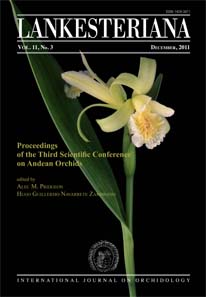Of greenish Encyclia: natural variation, taxonomy, cleistogamy, and a comment on DNA barcoding
DOI:
https://doi.org/10.15517/lank.v11i3.18288Keywords:
Orchidaceae, Laeliinae, Encyclia, Central America, taxonomy, cleistogamyAbstract
The species-level taxonomy of Encyclia has been disputed considerably because of the great morphological similarity among many of the taxa, particularly in the complex of species related to E. chloroleuca and E. gravida, characterized by small, greenish flowers. Current phylogenetic results are insufficient to assess the natural lineages of the greenish species of Encyclia, and species concepts in this group are discussed here independently from previous schemes of classification and current nomenclatural uses. In Mesoamerica, traditional taxonomic approaches shifted from broad views of species circumscriptions to the recognition of a large number of finely split taxa. However, the relative paucity of specimens available for study led both approaches to fail to appreciate the range of natural variation, with the consequence of nomenclatural inflation and misunderstanding of species diversity. On the basis of a better sample, we reduce the supposedly rare and variable E. amanda to synonymy of E. chloroleuca and discuss the case of cleistogamous individuals of Encyclia referred to E. gravida. On the basis of floral morphology, we suggest that the few documented records of E. gravida may simply represent self-pollinating forms belonging to different taxa.
Downloads
Downloads
Published
How to Cite
Issue
Section
License
According to the Open Access policy promoted by the University of Costa Rica, all the papers published by Lankesteriana are licensed under the Creative Commons copyright and can be downloaded free of charge. The journal holds copyright and publishing rights under the CC BY-NC-ND 3.0 CR license.
Before the publication of the materials submitted by the author(s) in LANKESTERIANA, the author(s) hereby assign all rights in the article to the Lankester Botanical Garden.





